河湖健康评估-生态系统健康监测计划
河湖健康评估利用大型底栖无脊椎动物进行河流生态系统健康评价

Predictor variables 深宽比、温度、底质类型I(≤2mm)、底质类型I (>256mm) Predictive model validation
表1. 漓江源头猫儿山期望出现的具体分类单元和实际观测到的分类单元及数量
Baetidae Hydropsychidae Simuliidae Tipulidae Neochaliodes Neoneuromus Helodidae Parapoynx crisonalis Thalerosphyrus Philopotamidae Elmidae Tabanidae Hydrobiosidae Baetis Cheumatopsyche 四节蜉属 纹石蛾属 蚋科 大蚊 斑鱼蛉属 齿蛉属 沼甲科 草螟科 短鳃蜉属 等翅石蛾科 长角泥甲科 虻科 螯石蛾科 1 1 1 1 1 1 1 1 0.999 0.999 0.995 0.803 0.802 Ephemerellidae Nemouridae Baetidae Leptophlebiidae Leuctridae Heptageniidae Ephemerellidae Euphaeidae Hydrophilidae Psephenidae Gomphidae Cincticostella Nemoura Baetiella facialis Perlomyla Cinygmina Torleya 带肋蜉属 叉襀属 花翅蜉属 宽基蜉属 长卷襀属 似动蜉属 大鳃蜉属 溪蟌科 水龟虫科 扁泥甲科 春蜓属 涡虫 0.802 0.801 0.8 0.796 0.796 0.607 0.605 0.605 0.605 0.604 0.602 0.593
2.2 Data analysis Stepwise evaluating 36 candidate metrics. Crop, forest and urban land use in upstream watershed of every site were analyzed using satellite image and a Digital Elevation Model. Statistical analysis was performed by SPSS 16.0.
河湖健康评价总结及计划

河湖健康评价总结及计划河湖健康评价是保护水资源、维护生态平衡的重要手段。
本文将对我国近年来河湖健康评价工作进行总结,并提出未来评价计划,以期为我国河湖管理保护工作提供参考。
一、河湖健康评价工作总结1.评价方法及指标近年来,我国河湖健康评价工作主要采用“压力-状态-响应”(PSR)模型,结合河湖实际情况,构建了一套科学、合理的评价指标体系。
评价指标包括水质、水量、生物、生态、社会经济等多个方面,共计数十个指标。
2.评价成果通过河湖健康评价,我们掌握了我国河湖的基本状况,发现了一些突出问题,如下:(1)水质污染问题依然严重,部分河湖水质超标现象较为普遍。
(2)水资源过度开发,河湖生态水量不足,导致生态退化。
(3)河湖生物多样性下降,部分河湖生态系统受损。
(4)河湖周边区域社会经济活动对河湖健康产生较大压力。
3.评价成果应用河湖健康评价成果为我国河湖管理保护工作提供了有力支持,主要体现在以下几个方面:(1)指导河湖保护规划编制,明确保护目标和措施。
(2)为河湖污染治理、生态修复等工程提供科学依据。
(3)促进河湖管理体制改革,提高河湖管理水平。
(4)加强河湖健康监测,及时发现和解决河湖问题。
二、河湖健康评价计划1.评价目标未来河湖健康评价工作将以“改善河湖生态环境,保障水资源安全,促进人与自然和谐共生”为目标,为实现我国河湖健康可持续发展提供支撑。
2.评价范围及周期评价范围将覆盖全国各类河湖,包括大型河流、湖泊、水库等。
评价周期为5年,每年对部分河湖进行评价。
3.评价方法及指标体系继续采用“压力-状态-响应”模型,结合河湖特点,优化评价指标体系,增加生态红线、水资源承载能力等指标。
4.评价工作计划(1)开展河湖健康评价技术培训,提高评价人员业务水平。
(2)加强河湖健康监测能力建设,提高监测数据质量。
(3)定期发布河湖健康评价报告,推动评价成果应用。
(4)结合河湖保护规划,制定针对性的河湖保护措施。
总结:河湖健康评价作为一项长期、系统的工作,对于保护我国河湖资源具有重要意义。
幸福河湖的自评方案

幸福河湖的自评方案一、前言幸福河湖的建设是推进生态文明、建设美丽中国的重要内容。
为了科学、全面地评估幸福河湖的建设成果,制定本自评方案。
本方案旨在通过综合评估河湖健康、水质监测、生态保护、防洪排涝、水资源利用、景观与文化价值、公众参与和满意度等方面,为幸福河湖的持续改进提供依据。
二、评估指标1. 河湖健康评估:评估河湖生态系统健康状况,包括水生生物多样性、水域生态功能、河流地貌完整性等。
2. 水质监测与分析:定期对河湖水体进行水质监测,分析各项水质指标,评估水质状况及变化趋势。
3. 生态保护与修复:评估河湖生态保护措施的落实情况,以及受损生态系统的修复效果。
4. 防洪排涝能力:评估河道的行洪能力、排涝设施的排水能力,以及防洪排涝管理措施的有效性。
5. 水资源利用与管理:评估水资源开发利用的合理性、水资源管理体制的完善程度及水资源可持续利用情况。
6. 景观与文化价值:评估河湖景观的美学价值和文化内涵,以及景观建设与生态保护的协调性。
7. 公众参与与满意度:调查公众对幸福河湖建设的认知度和满意度,了解公众参与情况及建议。
8. 持续改进措施:评估幸福河湖建设中存在的问题及改进措施的落实情况,提出持续改进的建议。
三、评估方法1. 数据收集:收集相关数据和资料,包括监测数据、统计资料、实地调查等。
2. 数据分析:运用统计分析、对比分析等方法对数据进行处理和分析。
3. 现场调查:通过实地考察、访谈等方式了解实际情况,核实数据和信息的准确性。
4. 专家评估:邀请相关领域专家进行评估和审议,提高评估的科学性和权威性。
5. 结果呈现:将评估结果以量化的形式呈现,并根据实际情况提出改进建议和措施。
四、总结本自评方案通过综合评估幸福河湖的各个方面,旨在为河湖治理和保护提供科学依据。
通过本方案的实施,可以全面了解幸福河湖的建设成果和存在的问题,为后续的持续改进提供指导。
同时,本方案也可为其他地区开展幸福河湖建设提供借鉴和参考。
河湖水生态环境健康评估技术导则

河湖水生态环境健康评估技术导则河湖水生态环境健康评估,这个话题听起来是不是有点高大上?乍一听,大家可能会觉得这就是一些专家学者拿着复杂的公式,做着高深的分析。
说白了,就是咱们要关注和保护咱们的河流、湖泊水域,让它们既能滋养自然,也能保障我们的生活质量。
你想想,一条清澈的河流穿村而过,湖泊水面波光粼粼,野生动物在其中自由游弋,这才是美丽家园的画面,不是吗?怎么才能知道这些水域的“身体”是否健康呢?这就得靠一套完整的评估标准了。
简单来说,这个评估过程就像是给河湖做体检,看看它们有没有生病,得了什么病,怎么治疗。
就像咱们平时去医院做检查一样,水体也需要“量血压”,看水质是否合格;“查体温”,了解生态环境是否稳定;“做影像学检查”,看看水生生物是否活跃健康。
咱们先说说这“体检”要看什么?第一条就是水质。
水质不好,直接影响水里的生物生存,比如水里的鱼虾都可能受到影响,甚至死掉。
想象一下,如果你去河边玩,看到的只是垃圾漂浮、死鱼泛滥,那心情肯定大打折扣。
评估水质的好坏,得看看水里的氧气含量、营养盐的浓度,反正就是一堆“化学指标”。
水质如果不好,水里的藻类就会大量繁殖,水就变得浑浊,看着都让人心情不爽,严重了还可能导致“水华”现象,就是水面上长满绿藻,像一层绿色的“油膜”,看着就像毒气笼罩的感觉。
咱们得看看生物群落。
什么意思呢?简单来说,就是水里生活的各种小伙伴,比如鱼、虾、藻类等等。
它们就像是生态系统里的小工蜂,维持着整个生态平衡。
生物多样性高了,水体就说明比较健康。
你知道吗?如果某种水生生物的数量急剧减少,可能就意味着水体出了问题。
比如水草少了,鱼就没地方藏身,虾也没地方栖息,这个水域就像一座荒废的城市,没了生气。
再说说什么是“生态功能”。
这个听起来有点抽象,其实也很简单,水体的“功能”就是它能给周围的环境、生态系统、甚至咱们人类提供什么好处。
比如它能调节气候,净化空气,提供水源,养活动植物。
就像咱们的肾脏,没了它,身体就废了。
河湖健康评估

五河湖健康评估1调研背景概述河湖水系是地表水资源的主要载体,由河湖水系所支撑的河湖生态系统是地表最富生产力和生物多样性最为丰富的生态系统类型之一,具有巨大的生态服务功能,不仅承载着人类社会,也养育着众多的生物。
在经历了20世纪80年代以来长达30余年的我国经济社会的快速发展,全国各地河流不同程度地承受着过度排污、过度引水、河道结构破坏、过度捕捞等多重胁迫,相应地出现了水文情势显著变化、水质恶化、河流形态结构破坏、生境退化,以及重要或敏感水生生物消亡等问题,河流健康问题十分突出,河流生态完整性遭到严重破坏,严重影响河流对人类社会及生物多样性的支撑作用的发挥,影响着河流生态系统的生态服务功能的可持续利用。
在面临着“水多、水少、水浑”等传统水问题外,更日益面临着“水丑、水死”的严峻问题。
河湖健康的保持及恢复不仅关系到水资源的可持续利用,也关系到流域乃至全国生态安全和经济社会的可持续发展。
为此,河湖生态系统的保护及河湖健康的维持和恢复近年来日益成为全社会共同关注的重要问题,河湖生态修复的必要性和紧迫性也日益被全社会所认可。
作为水行政主管部门和流域健康的代言人,我国水利部门除了承担着防洪兴利的传统任务外,河湖生态恢复及河湖健康的守护重任也责无旁贷。
河湖健康评价是20世纪90年代以来在西方发达国家兴起的流域综合管理的技术手段,不仅可以对河湖生态系统的现状及存在的问题进行诊断评价,还可以为河湖生态修复的进程进行监测,从而不断地为河湖健康的适应性管理提供反馈信息,是河湖生态系统管理的重要内容,对实现水资源的综合管理和流域生态系统良性循环具有重要意义。
我国自21世纪初开始陆续引入河湖健康评价的理念,并在水利系统和其他部门迅速得到积极的回应。
国家和水利部门提出了树立科学发展观,以人-水和谐的理念,大力发展民生水利,实行最严格的水资源管理制度,促进水资源可持续利用的治水新思路。
环保部门在进行污染源总量控制治理的同时,也提出了“让河流休养生息”的河流保护行动。
河湖水域环境监测计划

河湖水域环境监测计划一、引言河湖水域一直是人类生存和发展的重要资源,但近年来由于人类活动和自然因素的影响,河湖水域环境面临严重挑战。
为了保护水域环境,有效管理和监测水质变化,制定和执行一个全面的监测计划变得至关重要。
本文旨在介绍河湖水域环境监测计划的目标和步骤,以确保水域环境的质量和可持续性。
二、监测目标和原则1. 监测目标本监测计划的主要目标是全面了解河湖水域环境的变化趋势,评估水质状况,发现和预警潜在的污染源,并为环境保护部门提供科学依据和参考,以制定环境保护政策和管理措施。
2. 监测原则(1)科学性:监测计划应基于科学研究和方法,确保数据的准确性和可靠性。
(2)全面性:监测范围应涵盖各个河湖水域类型和地理分布,以全面掌握水域环境情况。
(3)连续性:监测工作应持续进行,以捕捉水质变化的长期趋势。
(4)可比性:监测数据应采用一致的方法和标准,以便进行跨地区和跨时间段的比较分析。
三、监测内容和方法1. 监测内容(1)水质监测:包括监测水域中的溶解氧、水温、pH值、浊度、溶解性有机物、氮磷等关键指标,以评估水质状况。
(2)生物监测:通过对水域中生物群落的调查和样本采集,了解水域生态系统的健康状况。
(3)污染源监测:追踪和监测潜在污染源的排放情况,包括工业、农业和城市排污口。
(4)环境影响评估:对人类活动、自然灾害等因素对水域环境的影响进行评估。
2. 监测方法(1)采样方法:采用标准的水样采集方法,确保样品的代表性和可比性。
(2)实验分析:采用现代化的实验设备和方法,对水样进行分析和测试。
(3)生物调查方法:采用专业的生物学调查技术,包括水生生物抽样、物种鉴定等。
(4)遥感技术:结合遥感技术,借助高分辨率卫星图像进行区域性的水质监测和分析。
四、监测计划的执行与管理1. 监测站点选择根据水域类型、重点保护区域和目标污染源等因素,选择合适的监测站点,以确保监测范围的代表性和可靠性。
2. 监测频次和持续性确定监测的时间安排和频次,以确保监测数据的连续性和时效性。
河湖健康评价服务方案 (3)
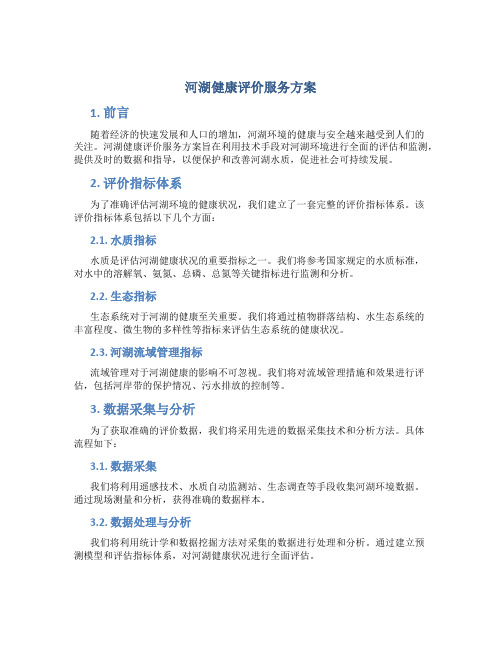
河湖健康评价服务方案1. 前言随着经济的快速发展和人口的增加,河湖环境的健康与安全越来越受到人们的关注。
河湖健康评价服务方案旨在利用技术手段对河湖环境进行全面的评估和监测,提供及时的数据和指导,以便保护和改善河湖水质,促进社会可持续发展。
2. 评价指标体系为了准确评估河湖环境的健康状况,我们建立了一套完整的评价指标体系。
该评价指标体系包括以下几个方面:2.1. 水质指标水质是评估河湖健康状况的重要指标之一。
我们将参考国家规定的水质标准,对水中的溶解氧、氨氮、总磷、总氮等关键指标进行监测和分析。
2.2. 生态指标生态系统对于河湖的健康至关重要。
我们将通过植物群落结构、水生态系统的丰富程度、微生物的多样性等指标来评估生态系统的健康状况。
2.3. 河湖流域管理指标流域管理对于河湖健康的影响不可忽视。
我们将对流域管理措施和效果进行评估,包括河岸带的保护情况、污水排放的控制等。
3. 数据采集与分析为了获取准确的评价数据,我们将采用先进的数据采集技术和分析方法。
具体流程如下:3.1. 数据采集我们将利用遥感技术、水质自动监测站、生态调查等手段收集河湖环境数据。
通过现场测量和分析,获得准确的数据样本。
3.2. 数据处理与分析我们将利用统计学和数据挖掘方法对采集的数据进行处理和分析。
通过建立预测模型和评估指标体系,对河湖健康状况进行全面评估。
4. 健康评估报告为了将评估结果更直观地展示给用户,我们将生成一份健康评估报告。
该报告将包括以下内容:4.1. 河湖健康状况总览通过数据分析和指标评估,在报告中将对河湖健康状况进行总览,给出评价结果。
4.2. 指标分析与解读针对每个评价指标,我们将进行分析和解读,解释其对河湖健康的影响和意义。
4.3. 健康改善建议根据评估结果,我们将提供一些建议和建议,以促进河湖健康的改善。
5. 服务价值通过河湖健康评价服务方案,可以为政府部门、环境保护组织以及广大公众提供以下价值:5.1. 提供决策依据评估报告将为政府部门制定河湖保护政策提供重要的决策依据。
河湖健康评价服务方案
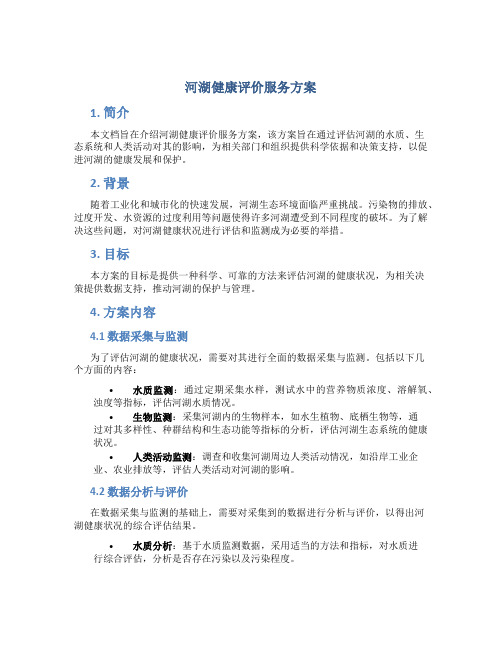
河湖健康评价服务方案1. 简介本文档旨在介绍河湖健康评价服务方案,该方案旨在通过评估河湖的水质、生态系统和人类活动对其的影响,为相关部门和组织提供科学依据和决策支持,以促进河湖的健康发展和保护。
2. 背景随着工业化和城市化的快速发展,河湖生态环境面临严重挑战。
污染物的排放、过度开发、水资源的过度利用等问题使得许多河湖遭受到不同程度的破坏。
为了解决这些问题,对河湖健康状况进行评估和监测成为必要的举措。
3. 目标本方案的目标是提供一种科学、可靠的方法来评估河湖的健康状况,为相关决策提供数据支持,推动河湖的保护与管理。
4. 方案内容4.1 数据采集与监测为了评估河湖的健康状况,需要对其进行全面的数据采集与监测。
包括以下几个方面的内容:•水质监测:通过定期采集水样,测试水中的营养物质浓度、溶解氧、浊度等指标,评估河湖水质情况。
•生物监测:采集河湖内的生物样本,如水生植物、底栖生物等,通过对其多样性、种群结构和生态功能等指标的分析,评估河湖生态系统的健康状况。
•人类活动监测:调查和收集河湖周边人类活动情况,如沿岸工业企业、农业排放等,评估人类活动对河湖的影响。
4.2 数据分析与评价在数据采集与监测的基础上,需要对采集到的数据进行分析与评价,以得出河湖健康状况的综合评估结果。
•水质分析:基于水质监测数据,采用适当的方法和指标,对水质进行综合评估,分析是否存在污染以及污染程度。
•生态系统评估:通过生物监测数据和其他环境数据,评估河湖生态系统的状况,包括生物多样性、生态功能等。
•环境风险评估:基于人类活动监测数据,评估人类活动对河湖的环境风险程度,指导相关管理措施的制定。
4.3 结果报告与决策支持根据数据分析与评价的结果,生成相应的结果报告,并提供相应的决策支持。
•结果报告:根据数据分析的结果,编写详细的结果报告,包括河湖健康状况评估、主要问题及建议等内容。
•决策支持:根据结果报告,为相关决策提供科学依据和建议,推动河湖保护与管理工作的决策实施。
河湖健康评价工作计划范文

河湖健康评价工作计划范文一、前言河湖是人类生存和发展的重要资源,对于整个自然生态系统有着重要的作用。
然而在工业化和城市化的进程中,河湖水体受到了严重的污染和破坏,其生态系统也遭受了严重的破坏。
因此,对河湖健康状况进行评价和监测是至关重要的。
本文将对河湖健康评价工作进行详细的计划和安排。
二、评价目标1. 了解河湖水质状况,掌握主要污染物种类和浓度变化情况。
2. 评估河湖水生态系统的状况,包括水生植物和动物种群的种类和数量。
3. 掌握人类活动对河湖健康的影响,包括工业废水、生活污水和农业面源污染等。
4. 根据评价结果,制定相应的保护和治理计划,促进河湖生态系统的健康发展。
三、评价内容1. 水质评价:通过对水质的监测,包括PH值、溶解氧、化学需氧量(COD)、氨氮、氮磷比等指标的监测,评估水质的优劣状况。
2. 生态系统评价:通过鱼类和水生植物的调查和监测,评估河湖生态系统的状况,包括物种多样性和数量分布情况。
3. 污染源调查:对周边的工业排污口、农业污染和生活污水进行调查,评估污染源的种类和排放情况。
4. 社会经济调查:了解周边居民的生活方式和生产方式,评估人类活动对河湖健康的影响。
四、评价方法1. 采样监测:通过定点采样和实时监测的方法,对河湖水体进行监测和采样,获取水质、生态系统和污染源的信息。
2. 调查研究:通过问卷调查和实地调研的方式,了解周边居民和企业的生产和生活方式,评估其对河湖健康的影响。
3. 实验分析:对采样的水样和生物样本进行实验室分析,获取水质和生态系统的具体数据。
4. 模型模拟:借助数学模型和地理信息系统(GIS)技术,模拟河湖水质和生态系统的变化趋势,提供预测和预警信息。
五、评价程序1. 确定评价范围:确定评价的河湖范围和评价对象,包括重点监测断面、生态系统关键地点和污染源分布范围。
2. 采样监测:根据评价范围和对象,进行定点采样和实时监测,获取水质、生态系统和污染源的信息。
3. 调查研究:进行问卷调查和实地调研,了解周边居民和企业的生产和生活方式,评估其对河湖健康的影响。
河湖健康评价服务方案 (5)

河湖健康评价服务方案1. 背景介绍河湖是人类社会发展的重要资源,也是生态环境的重要组成部分。
然而,由于人类活动和自然因素的综合影响,很多河湖面临着严重的污染和生态破坏问题。
因此,对河湖的健康状况进行评价和监测非常重要。
本文档旨在提出一套河湖健康评价服务方案,通过系统的数据收集和分析,为相关部门和社会公众提供科学的河湖健康评价数据和决策支持。
2. 数据采集2.1 定量数据采集通过建立河湖监测站,利用现代化的传感器设备进行定量数据采集,包括水质、水温、溶解氧、浊度等参数。
监测站的位置应遍布河湖的不同区域,以覆盖不同水域类型和利用方式。
数据采集频率应根据河湖的特性进行合理设置,以确保数据的准确性和时效性。
2.2 定性数据采集除了定量数据采集外,还应进行定性数据采集,包括对河湖生态系统的植被调查、鱼类和其他水生生物的密度和多样性调查等。
这些定性数据可以提供更多的生态信息,对河湖的健康评价有重要的参考价值。
3. 数据分析3.1 统计分析对采集到的数据进行统计分析,包括计算各项水质指标的平均值、标准差和变异系数,以及相关指标之间的相关性。
通过统计分析,可以客观地评估河湖的水质状况,及时发现潜在的问题。
3.2 空间分析通过利用地理信息系统(GIS)技术,将采集到的定量和定性数据进行空间分析,揭示河湖水质和生态状况的空间分布特征。
通过空间分析,可以发现不同区域之间的差异,为河湖健康评价提供更细致和全面的信息。
4. 健康评价指标体系基于数据分析结果,建立河湖健康评价指标体系。
该指标体系应包括水质指标、生态指标和综合评价指标,可以通过设置不同的权重来反映不同指标的重要程度。
同时,应根据国家和地方的相关标准和指导意见,结合当地实际情况进行必要的调整。
5. 评价结果展示将评价结果进行可视化展示,利用图表、地图等手段直观地呈现河湖的健康状况和变化趋势。
评价结果的展示应简洁明了,便于相关部门和社会公众理解和采取相应的措施。
河湖健康评价服务方案 (4)
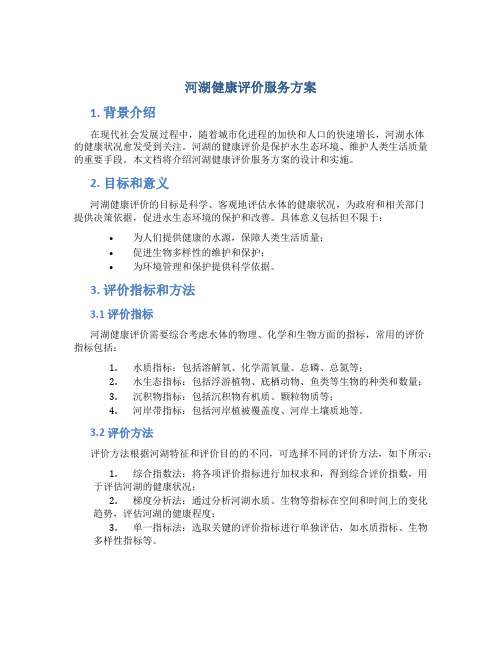
河湖健康评价服务方案1. 背景介绍在现代社会发展过程中,随着城市化进程的加快和人口的快速增长,河湖水体的健康状况愈发受到关注。
河湖的健康评价是保护水生态环境、维护人类生活质量的重要手段。
本文档将介绍河湖健康评价服务方案的设计和实施。
2. 目标和意义河湖健康评价的目标是科学、客观地评估水体的健康状况,为政府和相关部门提供决策依据,促进水生态环境的保护和改善。
具体意义包括但不限于:•为人们提供健康的水源,保障人类生活质量;•促进生物多样性的维护和保护;•为环境管理和保护提供科学依据。
3. 评价指标和方法3.1 评价指标河湖健康评价需要综合考虑水体的物理、化学和生物方面的指标,常用的评价指标包括:1.水质指标:包括溶解氧、化学需氧量、总磷、总氮等;2.水生态指标:包括浮游植物、底栖动物、鱼类等生物的种类和数量;3.沉积物指标:包括沉积物有机质、颗粒物质等;4.河岸带指标:包括河岸植被覆盖度、河岸土壤质地等。
3.2 评价方法评价方法根据河湖特征和评价目的的不同,可选择不同的评价方法,如下所示:1.综合指数法:将各项评价指标进行加权求和,得到综合评价指数,用于评估河湖的健康状况;2.梯度分析法:通过分析河湖水质、生物等指标在空间和时间上的变化趋势,评估河湖的健康程度;3.单一指标法:选取关键的评价指标进行单独评估,如水质指标、生物多样性指标等。
4. 数据采集和分析为了实施河湖健康评价服务方案,需要进行数据采集和分析工作。
4.1 数据采集数据采集包括以下几个方面:1.水体样品采集:选取不同水质区域进行采样,包括表层水样、底层水样等;2.生物样本采集:采集浮游植物、底栖动物、鱼类等生物样本;3.沉积物样品采集:采集沉积物样品,包括表层沉积物和深层沉积物;4.河岸带样品采集:采集河岸带土壤、河岸植被等样本。
4.2 数据分析数据分析主要包括对采集的样品进行实验室分析,包括化学分析、生物学分析等。
分析结果可根据评价指标和方法进行计算和统计,进而得出河湖的健康状况评价结果。
河湖健康评价的实施方案
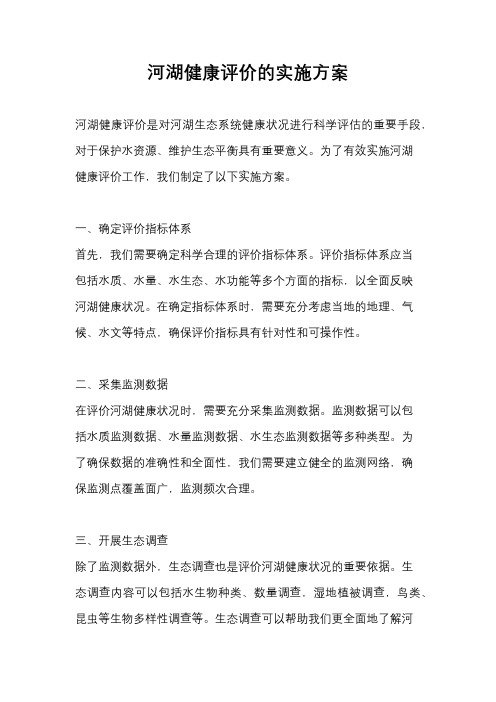
河湖健康评价的实施方案河湖健康评价是对河湖生态系统健康状况进行科学评估的重要手段,对于保护水资源、维护生态平衡具有重要意义。
为了有效实施河湖健康评价工作,我们制定了以下实施方案。
一、确定评价指标体系首先,我们需要确定科学合理的评价指标体系。
评价指标体系应当包括水质、水量、水生态、水功能等多个方面的指标,以全面反映河湖健康状况。
在确定指标体系时,需要充分考虑当地的地理、气候、水文等特点,确保评价指标具有针对性和可操作性。
二、采集监测数据在评价河湖健康状况时,需要充分采集监测数据。
监测数据可以包括水质监测数据、水量监测数据、水生态监测数据等多种类型。
为了确保数据的准确性和全面性,我们需要建立健全的监测网络,确保监测点覆盖面广,监测频次合理。
三、开展生态调查除了监测数据外,生态调查也是评价河湖健康状况的重要依据。
生态调查内容可以包括水生物种类、数量调查,湿地植被调查,鸟类、昆虫等生物多样性调查等。
生态调查可以帮助我们更全面地了解河湖生态系统的状况,为健康评价提供重要数据支撑。
四、综合评价分析在采集了监测数据和生态调查数据后,我们需要进行综合评价分析。
综合评价分析可以采用专家打分法、模型模拟法等多种方法,对河湖健康状况进行综合评定。
通过综合评价分析,可以客观地了解河湖的健康状况,为后续的保护和治理工作提供科学依据。
五、制定保护措施最后,根据评价结果,我们需要制定相应的保护措施。
保护措施可以包括水污染治理、水资源保护、生态修复等多个方面的内容。
制定科学合理的保护措施,可以有效改善河湖健康状况,实现水资源可持续利用和生态平衡。
综上所述,河湖健康评价的实施方案包括确定评价指标体系、采集监测数据、开展生态调查、综合评价分析和制定保护措施。
通过科学实施这些方案,可以全面客观地评价河湖健康状况,为河湖保护和管理提供科学依据,促进河湖生态环境的持续健康发展。
河湖健康评价工作方案范文
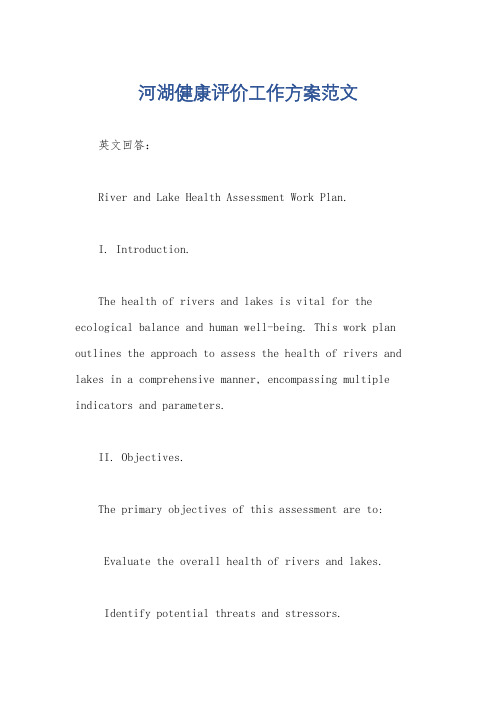
河湖健康评价工作方案范文英文回答:River and Lake Health Assessment Work Plan.I. Introduction.The health of rivers and lakes is vital for the ecological balance and human well-being. This work plan outlines the approach to assess the health of rivers and lakes in a comprehensive manner, encompassing multiple indicators and parameters.II. Objectives.The primary objectives of this assessment are to:Evaluate the overall health of rivers and lakes.Identify potential threats and stressors.Develop recommendations for restoration and management.III. Methodology.The assessment will utilize a multi-disciplinary approach, combining field surveys, data analysis, and modeling tools. The following indicators and parameterswill be considered:Physical: Flow regime, sediment transport, bank stability, riparian vegetation.Chemical: Water quality, nutrient levels, contaminant concentrations.Biological: Fish and invertebrate diversity, macrophyte abundance, aquatic habitat.Hydrological: Groundwater-surface water interactions, flow patterns, flood risk.IV. Data Collection.Data will be collected through a combination of:Field sampling.Remote sensing.Historical data.Stakeholder interviews.V. Data Analysis.Data will be analyzed using statistical tools and multivariate techniques to:Identify patterns and trends.Determine relationships between indicators and stressors.Develop health indices.VI. Reporting.The assessment results will be presented in a comprehensive report that includes:A detailed analysis of the health of rivers and lakes.Recommendations for restoration and management actions.A monitoring plan to track progress.VII. Stakeholder Engagement.Stakeholders will be actively involved throughout the assessment process:Provide input on data collection and analysis.Review assessment results.Participate in developing management recommendations.VIII. Timeframe.The assessment will be conducted over a period of [specify timeframe].IX. Resources.The assessment will require collaboration among multiple organizations and agencies. Funding and personnel will be secured to ensure successful completion.中文回答:河流湖泊健康评价工作方案。
河湖健康评价导则
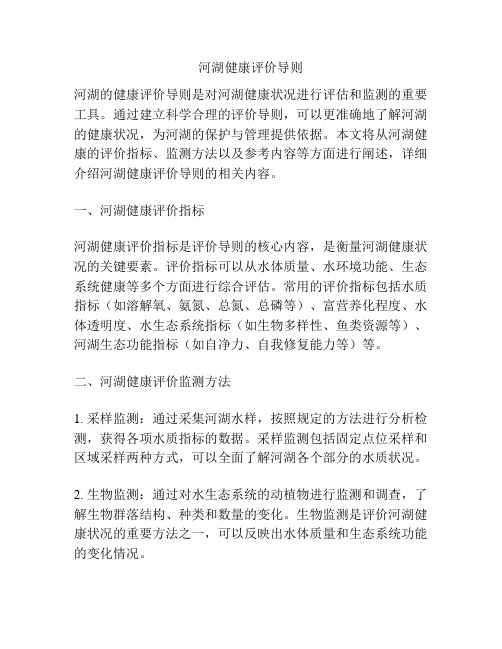
河湖健康评价导则河湖的健康评价导则是对河湖健康状况进行评估和监测的重要工具。
通过建立科学合理的评价导则,可以更准确地了解河湖的健康状况,为河湖的保护与管理提供依据。
本文将从河湖健康的评价指标、监测方法以及参考内容等方面进行阐述,详细介绍河湖健康评价导则的相关内容。
一、河湖健康评价指标河湖健康评价指标是评价导则的核心内容,是衡量河湖健康状况的关键要素。
评价指标可以从水体质量、水环境功能、生态系统健康等多个方面进行综合评估。
常用的评价指标包括水质指标(如溶解氧、氨氮、总氮、总磷等)、富营养化程度、水体透明度、水生态系统指标(如生物多样性、鱼类资源等)、河湖生态功能指标(如自净力、自我修复能力等)等。
二、河湖健康评价监测方法1. 采样监测:通过采集河湖水样,按照规定的方法进行分析检测,获得各项水质指标的数据。
采样监测包括固定点位采样和区域采样两种方式,可以全面了解河湖各个部分的水质状况。
2. 生物监测:通过对水生态系统的动植物进行监测和调查,了解生物群落结构、种类和数量的变化。
生物监测是评价河湖健康状况的重要方法之一,可以反映出水体质量和生态系统功能的变化情况。
3. 遥感监测:利用遥感技术获取河湖表面的信息,通过遥感图像分析和解译,可以快速获得大范围的水质和生态信息。
遥感监测可以提供全面、实时的河湖健康评价数据,并为相关决策提供依据。
三、参考内容1. 水质评价标准:根据国家和地方的相关规定和标准,对不同水体进行评价,包括饮用水标准、地表水质量标准、河湖水功能区划标准等。
这些标准可以作为评价河湖健康的参考依据,用于判断水质是否达标。
2. 河湖生态系统评估指南:包括生态系统评估方法、指标体系和评估标准等内容。
这些指南可以帮助评估人员了解河湖生态系统的结构和功能,并判断生态系统的健康状况。
3. 生物多样性评估方法:从物种多样性、生态地位和生态功能等方面评估河湖的生物多样性水平和健康状况。
常用的方法包括样方调查、物种多样性指数计算等。
河湖健康评价导则
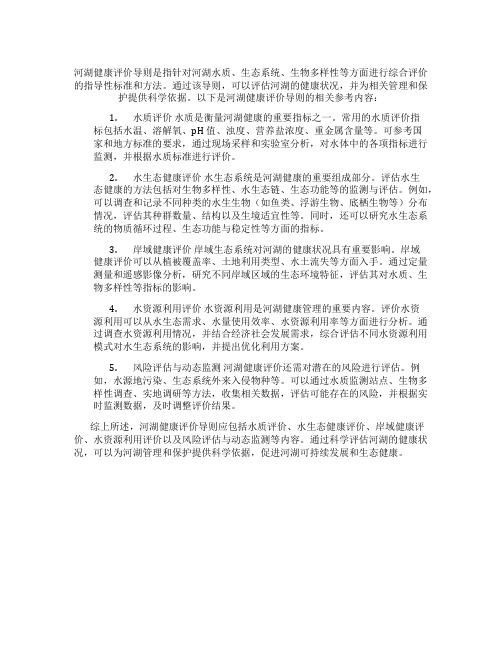
河湖健康评价导则是指针对河湖水质、生态系统、生物多样性等方面进行综合评价的指导性标准和方法。
通过该导则,可以评估河湖的健康状况,并为相关管理和保护提供科学依据。
以下是河湖健康评价导则的相关参考内容:1.水质评价水质是衡量河湖健康的重要指标之一。
常用的水质评价指标包括水温、溶解氧、pH 值、浊度、营养盐浓度、重金属含量等。
可参考国家和地方标准的要求,通过现场采样和实验室分析,对水体中的各项指标进行监测,并根据水质标准进行评价。
2.水生态健康评价水生态系统是河湖健康的重要组成部分。
评估水生态健康的方法包括对生物多样性、水生态链、生态功能等的监测与评估。
例如,可以调查和记录不同种类的水生生物(如鱼类、浮游生物、底栖生物等)分布情况,评估其种群数量、结构以及生境适宜性等。
同时,还可以研究水生态系统的物质循环过程、生态功能与稳定性等方面的指标。
3.岸域健康评价岸域生态系统对河湖的健康状况具有重要影响。
岸域健康评价可以从植被覆盖率、土地利用类型、水土流失等方面入手。
通过定量测量和遥感影像分析,研究不同岸域区域的生态环境特征,评估其对水质、生物多样性等指标的影响。
4.水资源利用评价水资源利用是河湖健康管理的重要内容。
评价水资源利用可以从水生态需求、水量使用效率、水资源利用率等方面进行分析。
通过调查水资源利用情况,并结合经济社会发展需求,综合评估不同水资源利用模式对水生态系统的影响,并提出优化利用方案。
5.风险评估与动态监测河湖健康评价还需对潜在的风险进行评估。
例如,水源地污染、生态系统外来入侵物种等。
可以通过水质监测站点、生物多样性调查、实地调研等方法,收集相关数据,评估可能存在的风险,并根据实时监测数据,及时调整评价结果。
综上所述,河湖健康评价导则应包括水质评价、水生态健康评价、岸域健康评价、水资源利用评价以及风险评估与动态监测等内容。
通过科学评估河湖的健康状况,可以为河湖管理和保护提供科学依据,促进河湖可持续发展和生态健康。
河湖健康评价服务方案 (2)
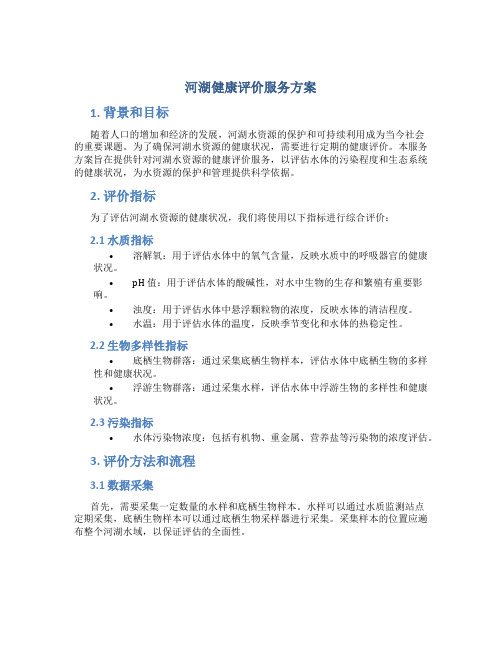
河湖健康评价服务方案1. 背景和目标随着人口的增加和经济的发展,河湖水资源的保护和可持续利用成为当今社会的重要课题。
为了确保河湖水资源的健康状况,需要进行定期的健康评价。
本服务方案旨在提供针对河湖水资源的健康评价服务,以评估水体的污染程度和生态系统的健康状况,为水资源的保护和管理提供科学依据。
2. 评价指标为了评估河湖水资源的健康状况,我们将使用以下指标进行综合评价:2.1 水质指标•溶解氧:用于评估水体中的氧气含量,反映水质中的呼吸器官的健康状况。
•pH 值:用于评估水体的酸碱性,对水中生物的生存和繁殖有重要影响。
•浊度:用于评估水体中悬浮颗粒物的浓度,反映水体的清洁程度。
•水温:用于评估水体的温度,反映季节变化和水体的热稳定性。
2.2 生物多样性指标•底栖生物群落:通过采集底栖生物样本,评估水体中底栖生物的多样性和健康状况。
•浮游生物群落:通过采集水样,评估水体中浮游生物的多样性和健康状况。
2.3 污染指标•水体污染物浓度:包括有机物、重金属、营养盐等污染物的浓度评估。
3. 评价方法和流程3.1 数据采集首先,需要采集一定数量的水样和底栖生物样本。
水样可以通过水质监测站点定期采集,底栖生物样本可以通过底栖生物采样器进行采集。
采集样本的位置应遍布整个河湖水域,以保证评估的全面性。
3.2 数据分析采集到的样本数据将进行实验室分析,得到各项评价指标的具体数值。
根据指标的标准范围和权重,计算出综合评价指数。
3.3 结果呈现评估结果将以报告的形式呈现,包括各项评价指标的具体数值、综合评价指数,以及对水体健康状况的评估和建议。
4. 服务内容和收费4.1 服务内容•水质监测和分析:包括溶解氧、pH 值、浊度、水温等水质指标的监测和分析。
•生物样本采集和分析:包括底栖生物群落和浮游生物群落的采集和分析。
•污染物浓度监测和分析:包括有机物、重金属、营养盐等污染物浓度的监测和分析。
4.2 收费方式针对不同的服务内容,收费方式如下:•水质监测和分析:按照每个监测指标的次数和样本数量计费。
河湖健康评价工作方案

河湖健康评价工作方案随着社会的发展,人们更加重视环境保护和资源利用。
河湖是人类的重要资源,也是维护地球环境的重要因素。
为了保护河湖资源,对其进行健康评估是必要的。
本文通过对河湖健康评估工作方案进行分析,详细描述了河湖健康评估工作方案的具体内容。
首先,制定河湖健康评估标准。
河湖健康评估标准主要包括水质指标、生物指标、地质指标、污染源指标、水文指标等五大类。
水质指标包括温度、溶解氧、酸碱度、水清澈程度等;生物指标包括物种多样性、生物量等;地质指标包括河床淤积度、沉积物类型等;污染源指标包括固体污染物、悬浮物、有机物等;水文指标则包括流速、流量、水位等。
其次,河湖健康评估工作方案要求建立相应的信息管理系统。
该系统包括河湖信息管理系统、评估报告管理系统和河湖质量指标监控系统。
河湖信息管理系统主要负责收集、管理和展示各类河湖资源数据和信息;评估报告管理系统主要负责管理各种河湖健康评估报告;河湖质量指标监控系统主要实时检测和监控河湖的质量指标,为河湖保护和治理提供科学参考。
此外,为了更好地实施河湖健康评估工作,还要组建专业的评估团队,并配备必要的野外调查与检测设备。
该团队包括水利工程师、环境污染专家、生态学家、经济学家和法律学家等。
野外调查设备包括水质检测仪、生物检测仪、地质检测仪等。
最后,河湖健康评估工作方案还明确了一些具体措施,以确保工作的有序实施。
首先,建立一套有效的宣传机制,以加强公众对河湖保护、资源利用和环境保护的意识;其次,建立科学有效的管理机制,以确保河湖环境健康评估工作的有效落实;最后,定期对河湖污染情况进行监测,及时阻止和调控河湖污染。
总之,河湖健康评估工作是实施河湖环境保护、资源利用和社会可持续发展的必要手段,其具体内容包括制定河湖健康评估标准、建立河湖信息管理系统、组建专业的评估团队和设备、以及确保工作有序实施等。
从根本上说,河湖健康评估工作的有效实施,需要政府的监管和支持,社会的优先发展,以及涉及人员的共同努力。
全国重要河湖健康评估调查监测技术细则

全国重要河湖健康评估调查监测技术细则一、背景介绍为了保护和治理全国的重要河湖资源,全国启动了健康评估(试点)调查监测工作。
该工作旨在评估当前河湖资源的健康状况,为后续的保护和治理提供科学依据。
本技术细则旨在规范相关的调查监测工作,确保数据的准确性和可比性。
二、监测指标及方法1.水质监测a.对于水质监测,应根据国家水环境质量标准要求,选择合适的监测因子和监测点位,包括pH值、溶解氧、氨氮、亚硝酸盐氮、硝酸盐氮、总氮、总磷、总有机碳等。
监测点位应覆盖整个河湖流域,并保持一定的时空分布。
b.监测方法应采用标准方法,确保监测数据的准确性和可比性。
同时,应配备专业的监测设备和实验室,以保障监测工作的顺利进行。
2.底质监测a.底质监测主要评估河湖底质的质量情况,包括颗粒大小、沉积物组成、营养物质含量等。
监测应选择合适的样点和采样方法,并结合实地调查,进行综合评价。
b.监测数据应按照标准方法进行分析和处理,以评估河湖底质的健康状况。
3.水生态监测a.水生态监测主要评估河湖的生物多样性、种群数量和结构等指标,包括鱼类、浮游生物、底栖动物等。
b.监测方法应根据实际情况选择合适的采样方法和样本处理方法,并进行充分的样本鉴定和分类。
4.水量监测a.水量监测主要评估河湖的水量变化情况,包括水位、流量和涨落幅度等指标。
b.监测应选择合适的监测点位和采样方法,并保持一定的时空覆盖。
三、监测数据的处理与分析监测数据的处理和分析应遵循统一的标准和方法。
数据分析应包括数据质量评估、数据清洗和校正、主要指标计算和评价等步骤。
同时,还应进行数据的统计分析、时空分布分析和趋势分析等,以评估河湖资源的健康状况。
四、调查监测报告的编制调查监测报告应根据实际情况编制,内容应包括调查目的、调查方法、监测数据分析、评价结果和对策建议等。
同时,还应提供数据的图表展示和统计分析结果,以便于相关部门和公众了解河湖资源的健康状况。
五、数据共享和应用调查监测数据的共享和应用应遵循相关规范和政策,数据应按照统一的格式和标准进行共享,并建立数据交换平台和数据库,以方便相关部门和公众的访问和利用。
河湖健康评价工作方案

河湖健康评价工作方案河湖健康评价工作方案是一个综合性的、全面评价河湖生态环境质量的制度,是监测结果的综合判定。
根据中国环境保护部《河湖健康评价技术规范》及《河湖健康评价技术支持文件》等要求,河湖健康评价工作方案主要包括以下几个方面:(一)目标设定在开展河湖健康评价工作时,应根据河湖的生态环境状况,设定合理的评价目标,明确检测的指标体系,并制定合理的指标控制范围,以确保评价的准确性。
(二)现场监测现场监测是河湖健康评价工作的基础,是对河湖生态环境进行实地考察和检测的过程。
主要包括水文气象监测、河流水质监测、湖泊水质监测、水生态环境监测、沿岸环境监测等。
(三)数据处理现场监测的结果是不可避免的模糊和不确定性,因此,必须对所获得的监测数据进行处理,使其更加清晰、准确。
处理方法包括数据校正、去噪、归一化、排序等。
(四)评价指标选取河湖健康评价工作以指标体系为基础,因此,要求评价指标的选取必须合理。
指标体系要能够反映河湖生态环境质量,并且要客观、可测、可比较。
(五)数据分析分析数据是河湖健康评价工作的核心,主要包括统计分析、地理信息系统分析、回归分析等。
通过这些分析,可以更加清晰地反映河湖生态环境质量,从而得出合理的结论。
(六)评估结论根据综合分析得出的结论,可以得出河湖健康评价结果,以便对河湖生态环境质量进行评估、判断。
(七)改善建议在评估河湖健康状况后,就需要提出改善建议,以便改善河湖生态环境质量,为后续的管理提供参考依据。
总之,河湖健康评价工作方案是一个综合性的、全面评价河湖生态环境质量的制度。
它主要包括目标设定、现场监测、数据处理、评价指标选取、数据分析、评估结论以及改善建议等内容,其中,现场监测是基础,数据分析是核心,评估结论是结果,改善建议是最终目的。
- 1、下载文档前请自行甄别文档内容的完整性,平台不提供额外的编辑、内容补充、找答案等附加服务。
- 2、"仅部分预览"的文档,不可在线预览部分如存在完整性等问题,可反馈申请退款(可完整预览的文档不适用该条件!)。
- 3、如文档侵犯您的权益,请联系客服反馈,我们会尽快为您处理(人工客服工作时间:9:00-18:30)。
i.e. mostly parameters that can be compared to an established guideline
i.e. Categorised, qualitative, not assessed against a guideline
BHR: Coral monitoring in Moreton Bay
Never lose sight of the big picture
Trends from long-term datasets (Case: Bremer River)
EHMP Freshwater Estuarine-Marine 2001 N/A F 2001 F F 2002 F F 2003 DF 2004 DF 2005 DF 2006 DF 2007 D D2008 DF 2009 D+ F
92
Freshwater Streams RC 2009
Improvements in biological indicators (macroinvertebrates and fish), reflecting positive influence of higher flows – more native species and lower proportion of alien fish. Decline in nutrient cycling processes in most reporting areas, reflecting the negative influence of catchment loads (with high nutrients) on the nutrient cycling processes in river systems.
Overall score of streams in 2009 (0.805) very similar to previous year’s (0.803).
Spring 2008
Autumn
Hale Waihona Puke Annual2009
Higher Higher Lower Lower Lower Higher Higher
New Products: On-line Report Card
Launch of health-e-waterways : Data Integration System for SEQ waterways – first product is on-line Report Card
Reality check:
Setting Guidelines Southeast
What goes into a Report Card Grade?
Estuarine Report Card Grade
Water Quality (EHI) (70%) Biological (BHR) (30%)
-
Bay: TN, Chl-a, Secchi depth, Sewage nitrogen (δ15N), Lyngbya Estuary: TN, TP, Chl-a, Turbidity, DO
2 1.8 1.6 1.4 1.2 1 0.8 0.6 0.4 0.2 0 YR05/06 YR04/05 YR03/04 Sites YR09/10 YR08/09 YR07/08 YR06/07 1 YR02/03 YR01/02 YR00/01 YR99/00 5 TP (m g/l)
Years
Doing the RAP
Riparian Assessment Tool
• records multiple attributes every second
Percentage
100 90 80 70 60 50 40 30 20 10 0
A lb e
45 46 33 58 47 51 54 28 29 95
Most publicised output of the SEQ Healthy Waterways Partnership Easy-to-understand snapshot of ecosystem health A to F Designed to provide an insight into the effectiveness of investments in waterway and catchment management Split into two reporting zones, freshwater and estuarine/marine Each has its own objectives, parameters, methods and analysis
Ecosystem Health Monitoring Program
Dr Julia Playford Director Water Quality and Aquatic Ecosystem Health
Where do we want to be?
Healthy Ecosystems Poor Ecosystem Health
% Natural for 18 Estuaries in South East Queensland in 2007
Estuary
46 55
5 82 75 62 47
B rt re m C Bri er ab s b ba a n ge e Tr M a r ee oo ch y O C ab xle oo y l C ture oo C me ur r ru a m Ep bin ra pa Lo h M oo gan lo ol ah N er an g N o Pi os m a pa m a Ta lle Pi b u ne dg Ti era ng al pa
Monitor Ecosystem Health of Waterways to:
•
Assess effectiveness of environmental protection measures (e.g. stormwater controls, STP upgrades, riparian vegetation) Meet discharge and other licensing requirements
Years
There have been substantial improvements in some aspects of the estuarine portion of the river system, but those improvements are not yet sufficient to result in changes in EHMP grades.
-
Bay: Seagrass distribution, Seagrass depth range, Coral cover Estuary: Seagrass distribution, Riparian assessment, Sewage nitrogen (δ15N), Nutrient mixing
•
Design of Estuarine/Marine Program
Implementation of Estuarine/Marine Program
Extension to Northern & Southern regions
Establish links between agencies Set objectives based on stakeholder needs
How is the Report Card Used?
Why has the Report Card been successful?
Because it’s really simple, A is good, F is bad and any grade change has been made for a definable reason (environmental or human induced) It has consistently generated lots of public interest, particularly following the launch – has become very political From an early stage it engaged a range of decision makers – politicians, catchment groups etc We tend to get a good media coverage from the launch
135 freshwater sites
254 estuarine and marine sites
Report Card Grades reflect ecosystem health of waterways (achieve environmental values)
What is the Report Card?
Design of Freshwater Trial of Freshwater Program Program
Implementation of Freshwater Program
The SEQ Waterways Ecosystem Health Report Card represents a comprehensive marine, estuarine and freshwater ecosystem health monitoring program (snapshot of the health of 18 catchments, 18 estuaries and 9 zones in Moreton Bay)
